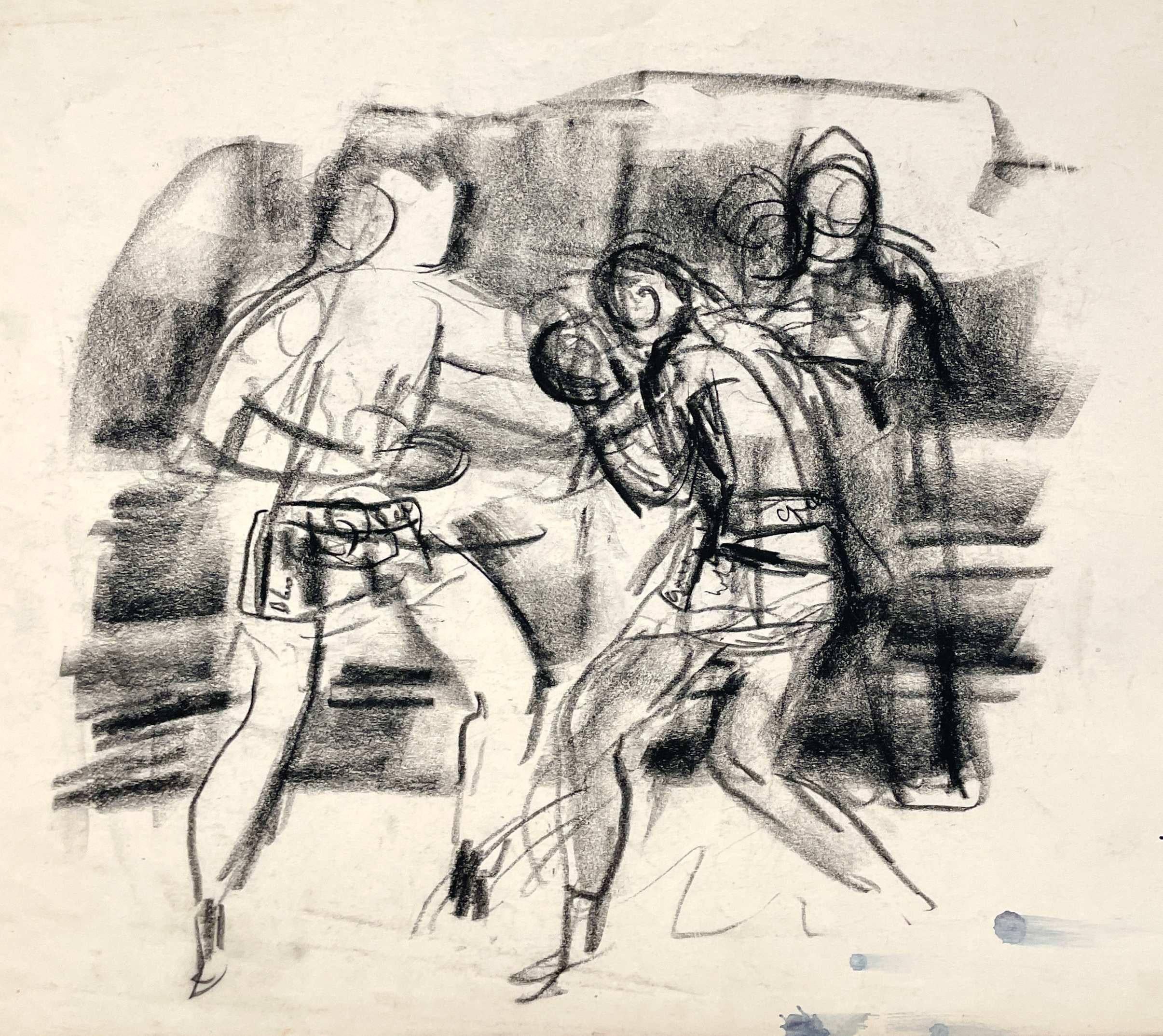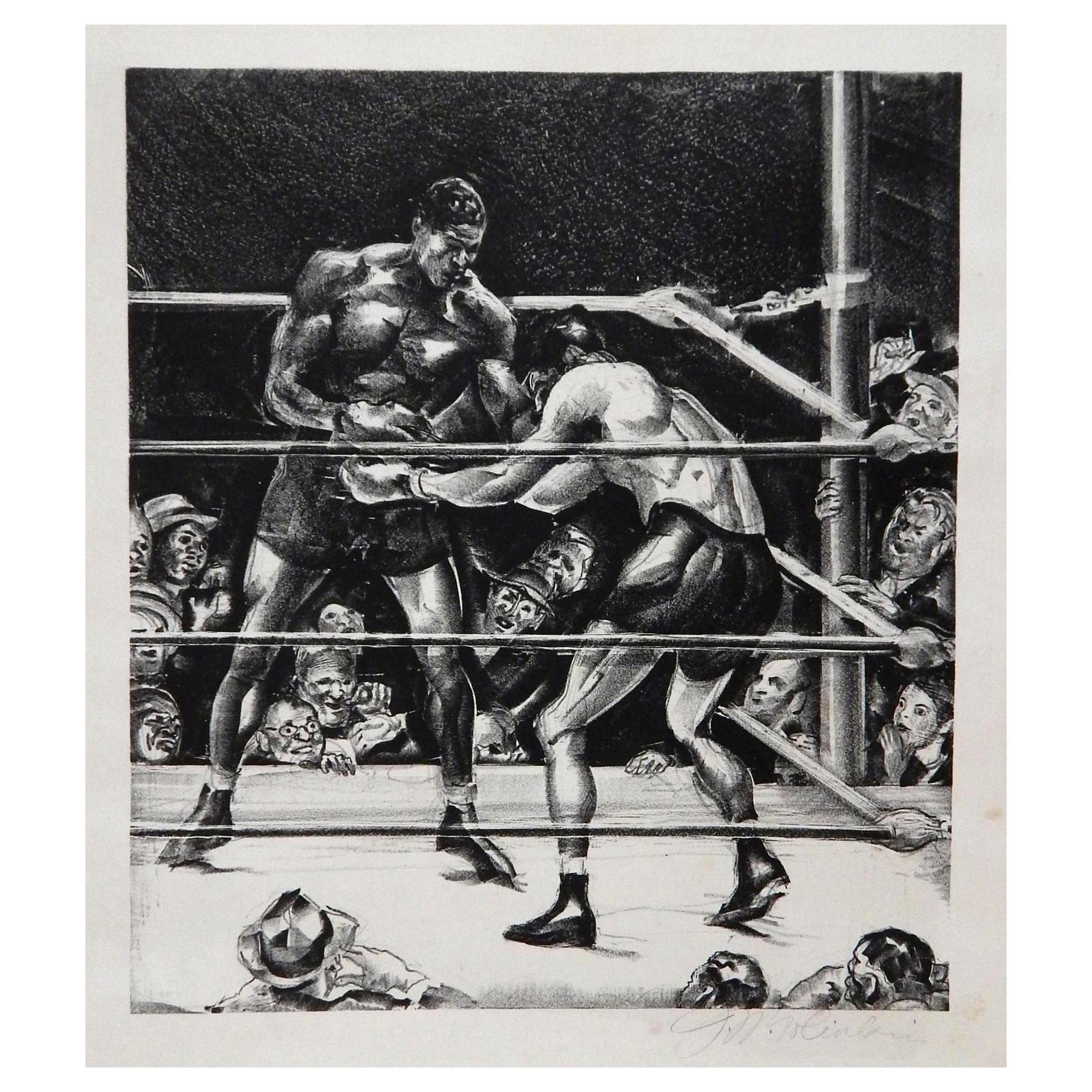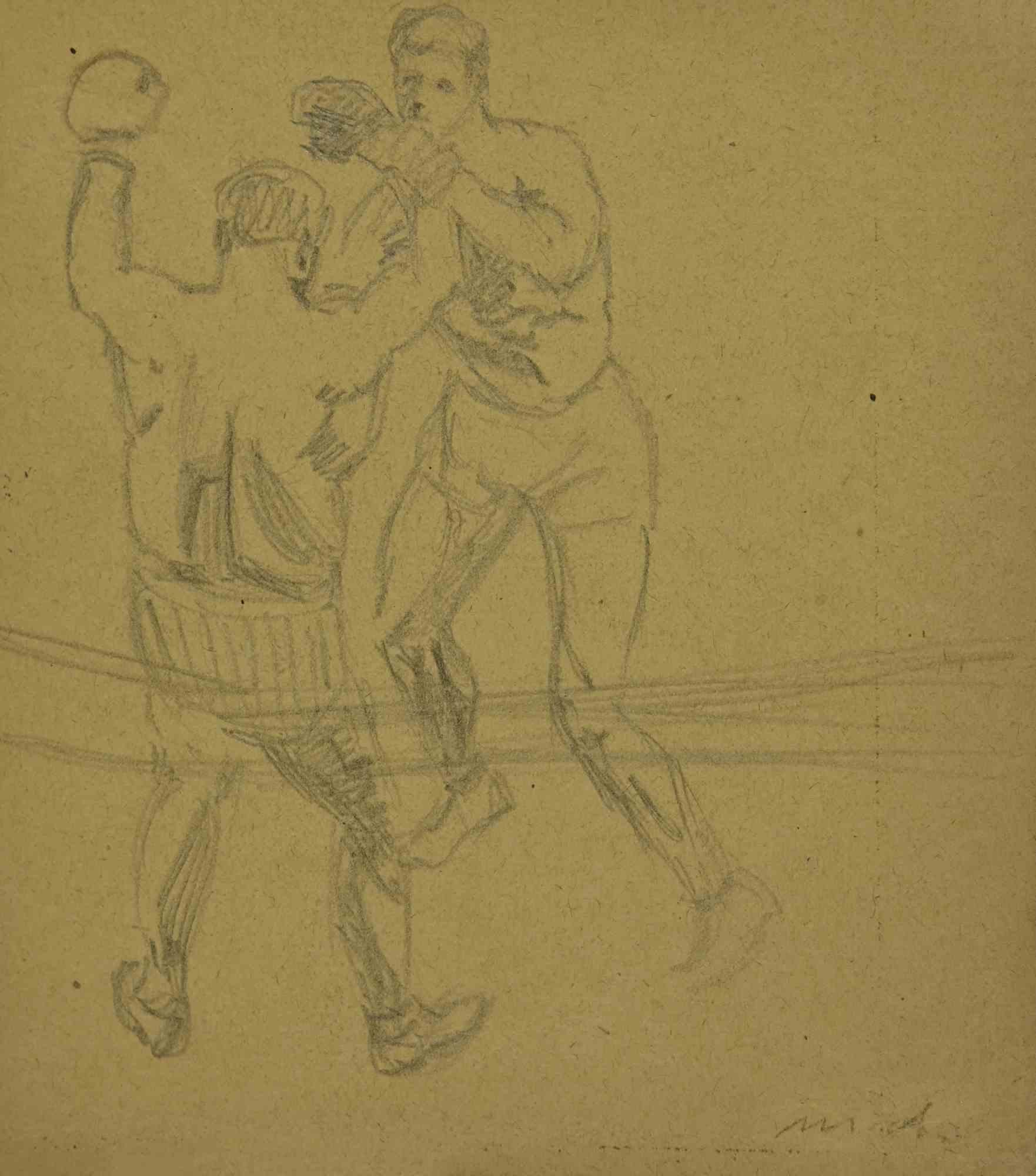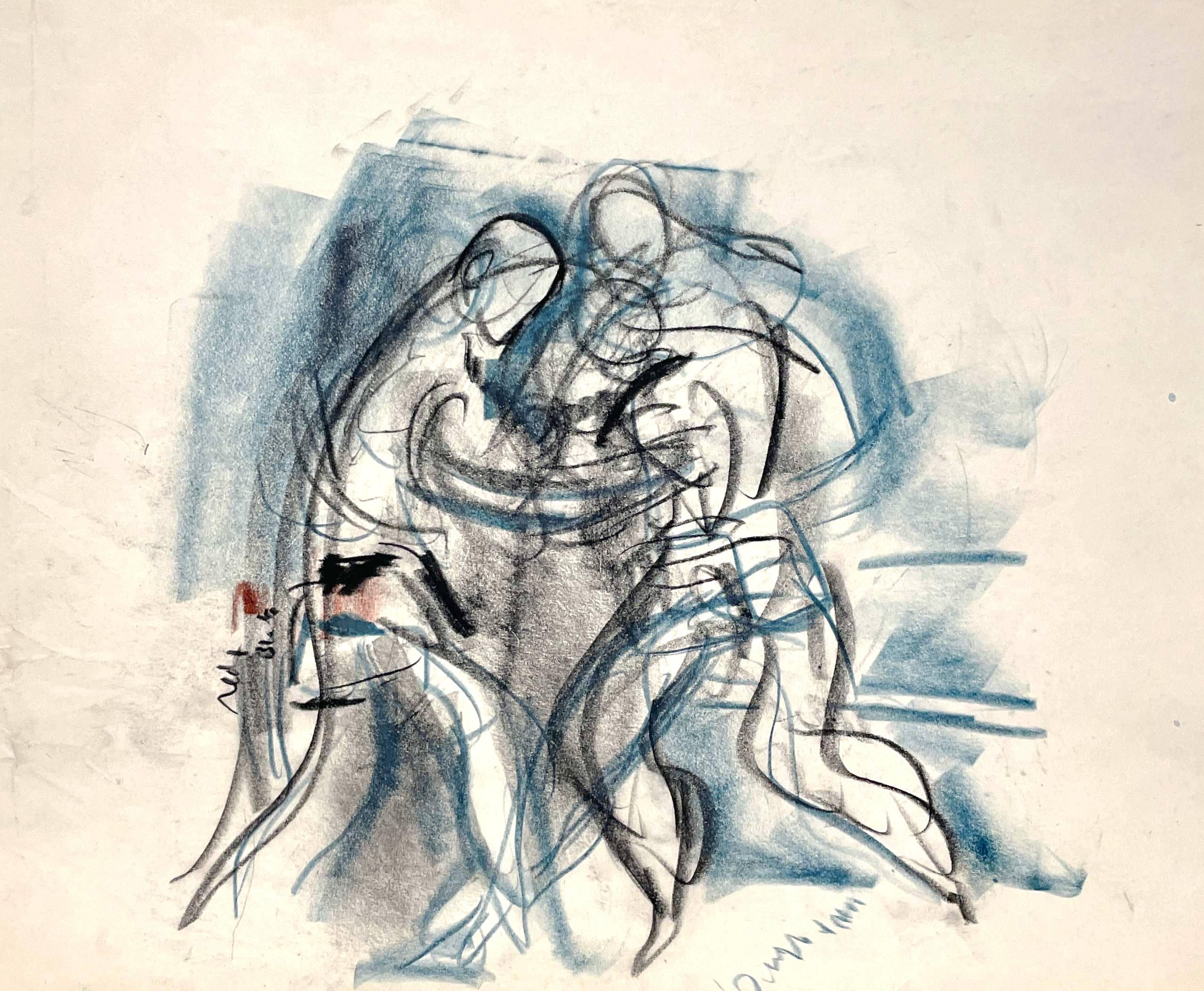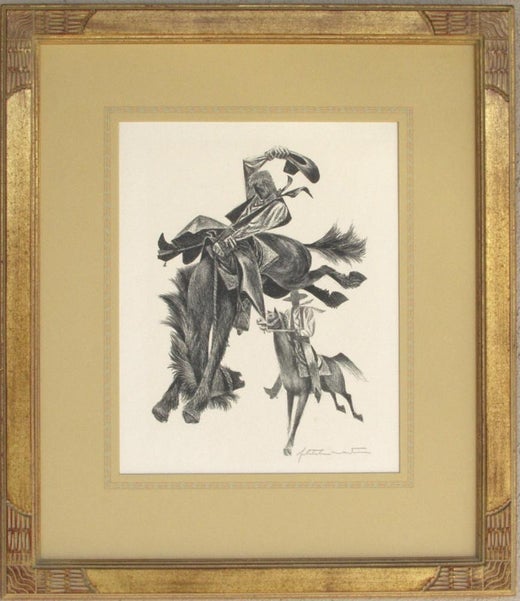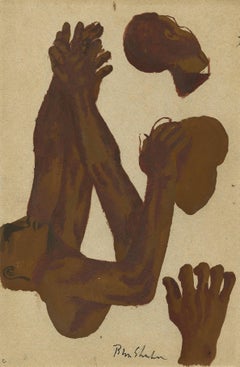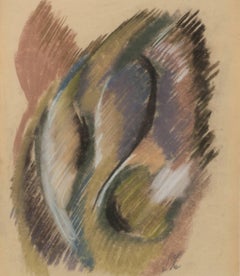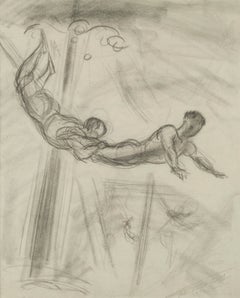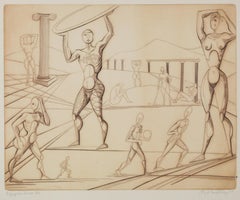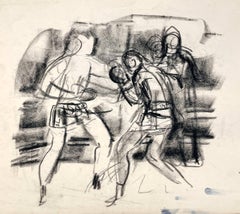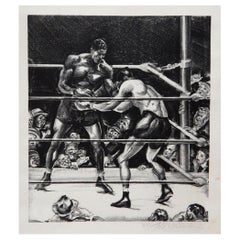Items Similar to Untitled (Joe Louis knocking out Max Schmeling in 1938 rematch)
Want more images or videos?
Request additional images or videos from the seller
1 of 6
Fletcher MartinUntitled (Joe Louis knocking out Max Schmeling in 1938 rematch)1938
1938
$4,000
£3,027.38
€3,474.56
CA$5,698.33
A$6,179.98
CHF 3,245.96
MX$75,066.29
NOK 40,618.03
SEK 38,244.15
DKK 25,951.02
About the Item
Untitled
(Joe Louis knocking out Max Schmeling in 1938 rematch)
Pen and ink with wash on heavy wove sketchbook paper, 1938
Signed lower right: Fletcher Martin
Directly related to Martin's famous painting of 1942 entitled "Lullaby", which was also used in the lithograph of the same name. (see photo)
The drawing depicts the third and final knockdown of Max Schmeling in their rematch of 1938.
Condition: Mat staining at the edges of the sketchbook page edges
Toning to verso from previous framing.
Does not affect framed presentation
"It was here that Louis first used sport to bridge America's cavernous racial divide. With Hitler on the march in Europe and using Schmeling's victory over Louis as proof of “Aryan supremacy,” anti-Nazi sentiment ran high in the States. Louis had long grown accustomed to the pressures of representing his race but here the burdens were broader and deeper. Now he was shouldering the hopes of an entire nation.
A few weeks before the match Louis visited the White House and U.S. President Franklin Delano Roosevelt, whose tenure lasted even longer than Louis' would, told him, “Joe, we need muscles like yours to beat Germany.”
Those muscles certainly beat Schmeling on fight night. Before an electric crowd of 70,043 and a worldwide radio audience that numbered more than 100 million, Louis fought as if possessed by an avenging apparition. Louis crowded the challenger at every opportunity while hammering him with punishing combinations. Schmeling, fighting out of a leaning-back crouch, barely threw a punch, much less landed one of consequence.
After pushing Schmeling to the ropes, Louis unloaded a series of bombs, one of which was a right that fractured three vertebrae in Schmeling's back, and another that scored a but-for-the-ropes knockdown that drew a brief count from referee Donovan. A crushing right dropped Schmeling for a two-count seconds later and a right to the side of the head caused the challenger to touch both gloves to the canvas. An explosive right to the jaw scored the third official knockdown and caused Schmeling's handlers to run into the ring, ending the fight just 124 seconds after it began. Those listening to the radio broadcast in Germany never heard the end of the fight, for the signal was cut the moment after Schmeling screamed in pain from Louis' punch to the back."
Courtesy of Ring TV
- Creator:Fletcher Martin (1904-1979, American)
- Creation Year:1938
- Dimensions:Height: 13.5 in (34.29 cm)Width: 9.75 in (24.77 cm)
- Medium:
- Movement & Style:
- Period:
- Condition:Mat staining at the edges of the sketchbook page edges Toning to verso from previous framing Does not affected framed presentation.
- Gallery Location:Fairlawn, OH
- Reference Number:Seller: FA118021stDibs: LU14013764122
Fletcher Martin
Fletcher Martin was an American painter, illustrator, muralist and educator. He is best known for his images of military life during World War II and his sometimes brutal images of boxing and other sports. Martin was born in 1904 in Palisade, Colorado, one of seven children of newspaperman Clinton Martin and his wife Josephine. The family relocated to Idaho and later Washington. By the age of 12, he was working as a printer. He dropped out of high school and held odd jobs such as lumberjack and professional boxer. He served in the U.S. Navy, 1922–26. Martin's artistic skills were largely self-taught.
About the Seller
5.0
Recognized Seller
These prestigious sellers are industry leaders and represent the highest echelon for item quality and design.
Platinum Seller
Premium sellers with a 4.7+ rating and 24-hour response times
Established in 1978
1stDibs seller since 2013
815 sales on 1stDibs
Typical response time: <1 hour
Associations
International Fine Print Dealers Association
- ShippingRetrieving quote...Shipping from: Fairlawn, OH
- Return Policy
Authenticity Guarantee
In the unlikely event there’s an issue with an item’s authenticity, contact us within 1 year for a full refund. DetailsMoney-Back Guarantee
If your item is not as described, is damaged in transit, or does not arrive, contact us within 7 days for a full refund. Details24-Hour Cancellation
You have a 24-hour grace period in which to reconsider your purchase, with no questions asked.Vetted Professional Sellers
Our world-class sellers must adhere to strict standards for service and quality, maintaining the integrity of our listings.Price-Match Guarantee
If you find that a seller listed the same item for a lower price elsewhere, we’ll match it.Trusted Global Delivery
Our best-in-class carrier network provides specialized shipping options worldwide, including custom delivery.More From This Seller
View AllBasketball Player
By Ben Shahn
Located in Fairlawn, OH
Basketball Player
Gouache on card stock, c. 1940
Signed by the artist in ink lower center
A study for the fresco mural in the Social Security Buildin...
Category
1940s American Modern Figurative Paintings
Materials
Gouache
Untitled
By Leon Kelly
Located in Fairlawn, OH
Untitled
Pastel on paper, 1922
Initialed lower right (see photo)
Exhibited: Francis Nauman, Leon Kelly: Draftsman Extraordinaire, New York, April 4 - May 23, 2014.
Condition: Excell...
Category
20th Century American Modern Abstract Drawings and Watercolors
Materials
Pastel
$4,000
Untitled (Study for The Aerialists)
By John Steuart Curry
Located in Fairlawn, OH
Untitled (Study for The Aerialists)
Graphite on paper, 1932
Signed lower right in pencil: "John Steuart Curry"
Dated: 1932 in pencil
Exhibited:
Schroeder Romero & Shredder, NYC (label), Master Drawings, Oct. 13, 2011-Nov. 12, 2011 (see photo of label)
Arkansas Arts Center (label), 44th Collector Show & Sale, Nov. 30-December 30, 2012, Offered at $22,000.
(see photo of label)
This drawing is closely related to a painting by Curry entitled The Aerialists, 1932, once in the Erskine Collection, Cedar Rapids, Iowa. It is part of a group of preliminary drawings and three finished paintings executed by Curry around 1932 which were based on The Flying Cadonas. The painting The Flying Cadonas is an icon of American art purchased by the Whitney Museum of Art and now on permanent exhibition.
There are other know studies for these works, nos. 199 through 222 and in John Steuart Curry: Rural America, page 32 (Mongerson Wunderlich, Chicago, 1990.
Provenance:
Mrs. Kathleen Curry (artist’s widow), included in the estate schedule of works
Treadway Toomey Auction, Oak Park, Illinois, 2009
Don Joint, New York
An important American Regionalist drawing.
Like Grant Wood and Thomas Hart Benton, John Steuart Curry was a major American scene painter of the 1930s. His subjects were taken from American history and his most famous mural, The Tragic Prelude...
Category
1930s American Modern Figurative Drawings and Watercolors
Materials
Graphite
Olympian Games
By Ray H. French
Located in Fairlawn, OH
Olympian Games
Engraving, 1957
Signed, dated, titled and numbered (see photos)
Edition: 25 (7/25)
From the first and only edition, probably less than 8 impressions printed
Printed by the artist
Condition: Excellent
soft fold in upper left margin
Image size: 15 7/8 x 19 7/8 inches
Sheet size: 18 1/2 x 22 3/8 inches
Provenance: Estate of the artist
Martha A. French Revocable Trust
Item Reference
LU14013763732
Crucifixion, color etching, 1947
Item Reference
LU14013160582
The Web, engraving, 1950
Item Reference
LU14011892032
The Swan, mixed media (etching & soft ground), 1957
Item Reference
LU1404294651
Snowy Egret, engraving, 1954, third edition c. 1990, printed by the master printer Jon Clemens
Item Reference
LU1402253433
Debris, color etching, c. 1940, printed by the artist at the John Herron Art Institute, Indianapolis, Indiana
Item Reference
LU140331242
Crucifixion, engraving, 1958
Item Reference
LU140145330
Strange Animals, engraving, 1947
Item Reference
G130708140172
The Gull, engraving, 1955
Item Reference
LU14012448972
Moon Rays...
Category
1950s American Modern Figurative Prints
Materials
Engraving
Untitled (Kneeling Male Nude)
By David Smith
Located in Fairlawn, OH
Untitled (Kneeling Male Nude)
Graphite on paper, c. 1930
Unsigned
Annotated in pencil verso:
"This drawing was made by David Smith in the Matulka class at A. S. L. 1931
Signed
Doroth...
Category
1930s American Modern Drawings and Watercolor Paintings
Materials
Paper, Pencil
Untitled
By Leon Kelly
Located in Fairlawn, OH
Untitled
Pastel on paper, 1922
Signed with the artist's initials in pencil
Provenance: Estate of the artist
Francis M. Nauman (label)
Private collection, NY
A very early abstract/cubist work by Kelly. Created while the artist was studying with Arthur Carles in Philadelphia.
Leon Kelly (October 21, 1901 – June 28, 1982) was an American artist born in Philadelphia, PA. He is most well known for his contributions to American Surrealism, but his work also encompassed styles such as Cubism, Social Realism, and Abstraction. Reclusive by nature, a character trait that became more exaggerated in the 1940s and later, Kelly's work reflects his determination not to be limited by the trends of his time. His large output of paintings is complemented by a prolific number of drawings that span his career of 50 years. Some of the collections where his work is represented are: The Metropolitan Museum in New York, The Whitney Museum of American Art, the Museum of Modern Art, the Philadelphia Museum of Art, and Boston Public Library.
Biography
Kelly was born in 1901 at home at 1533 Newkirk Street, Philadelphia, PA. He was the only child of Elizabeth (née Stevenson) and Pantaleon L. Kelly. The family resided in Philadelphia where Pantaleon and two of his cousins owned Kelly Brothers, a successful tailoring business. The prosperity of the firm enabled his father to purchase a 144-acre farm in Bucks County PA in 1902, which he named "Rural Retreat" It was here that Pantaleon took Leon to spend every weekend away from the pressures of business and from the disappointments in his failing marriage. Idyllic and peaceful memories of the farm stayed with Leon and embued his work with a love of nature that emerged later in the Lunar Series, in Return and Departure, and in the insect imagery of his Surrealist work. "If anything," he once said,"I am a Pantheist and see a spirit in everything, the grass, the rocks, everything."
At thirteen, Leon left school and began private painting lessons with Albert Jean Adolphe, a teacher at the School of Industrial Art (now the University of the Arts) in Philadelphia. He learned technique by copying the works of the old masters and visiting the Philadelphia Zoo, where he would draw animals. Drawings done in 1916 and 1917 of elephants, snakes and antelope, as well as copies of old master paintings by Holbein and Michelangelo, heralded an impressive emerging talent. In 1917, he studied sculpture with Alexander Portnoff but his studies came to an abrupt halt with the start of World War I. Being too young to enlist, he joined the Quartermaster Corp at the Army Depot in Philadelphia, where he served for more than a year loading ships with supplies and, along with other artists, working on drawings for camouflage.
By 1920, the family's fortunes drastically changed. His father's business had failed due to the introduction of ready made clothing and his marriage, unhappy from the beginning, dissolved. Broken by circumstance Pantaleon left Philadelphia to begin a wandering existence looking for work leaving Leon to support his mother and grandmother. He found a job in 1920 at the Freihofer Baking Company where he worked nights for the next four years. Under these circumstances Leon continued to develop his skills in drawing and painting and learned of the revolutionary developments in art that were taking place in Paris.
During the day he was granted permission to study anatomy at the Philadelphia School of Osteopathy where he dissected a cadaver and perfected his knowledge of the human figure. He also met and studied etching with Earl Horter, a well known illustrator, who had amassed a significant collection of modern art which included work by Brancusi, Matisse, and Cubist works by Picasso and Braque. Among the artists around Horter was Arthur Carles, a charismatic and controversial painter who taught at the Pennsylvania Academy of Fine Arts. Leon enrolled in the Academy in 1922, becoming what Carles described as, "his best student".
In the next three years Leon work ranged from academic studies of plaster casts, to pointillism, to landscapes of Fairmount Park in Philadelphia, as well as a series of pastels showing influences from Matisse to Picasso. Clearly influenced by Earl Horter's collection and Arthur Carles he mastered analytical cubism in works such as The Three Pears, 1923 and 1925 experimented with Purism in Moon Behind the Italian House. In 1925 Kelly was awarded a Cresson Scholarship and on June 14 he left for Europe.
Paris
The first trip to Europe lasted for approximately three and a half months and introduced Kelly to a culture and place where he felt he belonged. Though he returned to the Academy in the Fall, he left for Europe again a few months later to begin a four-year stay in Paris. He moved into an apartment at 19 rue Daguerre in Paris and began an existence intellectually rich but in creature comforts, very poor. "I kept a cinderblock over the drain in the kitchen sink to keep the rats out of the apartment" he once explained. He frequented the cafes making acquaintances with Henry Miller, James Joyce and the critic Félix Fénéon as well as others. His days were split between copying old master paintings in the Louvre and pursuing modernist ideas that were swirling through the work of all the artists around him. The Lake, 1926 and Interior of the Studio, 1927, now in the Newark Museum.
Patrons during this time were the police official Leon Zamaran, a collector of Courbets, Lautrecs and others, who began collecting Kelly's work. Another was Alfred Barnes of the Barnes Collection in Philadelphia.
In 1929 Kelly married a young French woman, Henriette D'Erfurth. She appears frequently in paintings and drawings done between 1928 and the early 1930s.
Philadelphia
The stock market crash of 1929 made it impossible to continue living in Paris and Kelly and Henriette returned to Philadelphia in 1930. He rented a studio on Thompson Street and began working and participating in shows in the city's galleries. Work from 1930 to 1940 showed continuing influences and experimentation with the themes and techniques acquired in Paris as well as a brief foray into Social Realism. The Little Gallery of Contemporary Art purchased the Absinthe Drinker...
Category
1920s Abstract Abstract Drawings and Watercolors
Materials
Pastel
$4,000
You May Also Like
A Fine 1930's, Study of a Boxing Match
By Francis Chapin
Located in Chicago, IL
A Fine 1930's, Expressive charcoal drawing depicting a dynamic boxing scene. The sketch captures the energy and motion of two fighters in the ring, with a referee or spectator in the...
Category
1930s American Modern Figurative Drawings and Watercolors
Materials
Charcoal
"The Knockout" Boxing Sports American Watercolor WPA Mid-Century Modern 30s/40s
By Robert Riggs
Located in New York, NY
"The Knockout" Boxing Sports American Watercolor WPA Mid-Century Modern 30s/40s.
Robert Riggs (1896-1970)
The Knockout
22 x 30 inches watercolor on paper
Signed lower right
Framed: ...
Category
1930s American Modern Figurative Drawings and Watercolors
Materials
Paper, Watercolor
"Joe Louis Knocking Out Max Schmeling"
By Charles Ellis
Located in Fort Washington, PA
"Joe Louis Knocking Out Max Schmeling"
Charles F. Ellis passed on October 1st, 2004 at the age of 82. Mr. Ellis was hired
to teach illustration in 1971 ...
Category
20th Century Other Art Style Paintings
Materials
Acrylic, Board
Joseph Golinkin Original Lithograph, 1935, Louis-Baer Boxing Match
By Joseph Webster Golinkin
Located in Phoenix, AZ
This is an original lithograph by Chicago/New York artist and illustrator Joseph Webster Golinkin (1896-1977). This print is no. 12 of the edition of 50.
The print depicts the Joe Lo...
Category
1930s Figurative Paintings
Materials
Paper
Boxing - Drawing - Mid-20th Century
Located in Roma, IT
Boxing is a drawing realized in the Mid-20th Century.
Pencil on ivory-colored paper
Good conditions with slight foxing.
The artwork is realized through deft expressive strokes.
Category
Mid-20th Century Modern Figurative Drawings and Watercolors
Materials
Pencil, Paper
A Fine 1930's, Depiction of a Boxing Match
By Francis Chapin
Located in Chicago, IL
A Fine 1930's, Depiction of a Boxing Match by Francis Chapin. This dynamic drawing captures overlapping human forms rendered in expressive, gestural lines. There is a clear sense of ...
Category
1930s American Modern Figurative Drawings and Watercolors
Materials
Charcoal, Paper, Pastel
More Ways To Browse
Joe Louis
German Vintage Radios
Eduardo Garcia
Japanese Original Drawing
Jesus Christ Superstar
Joseph Lambert Cain
Juan De Dios
Marcel Mangin
Old Master Sketch
Salvador Dali Drawing
Antique Greek Costume
Chalk Head
Chinese Ink Wash
Chinese Pith Rice Paintings
Dolly Dingle
English Watercolor Study
Frieze Drawing
John India
